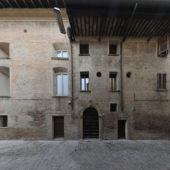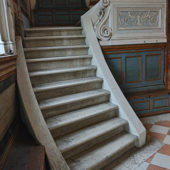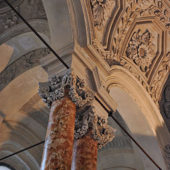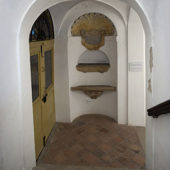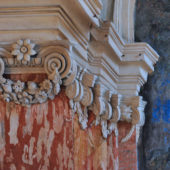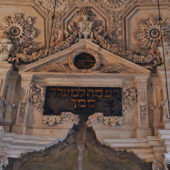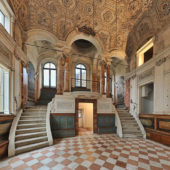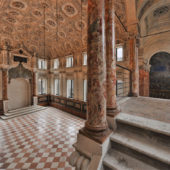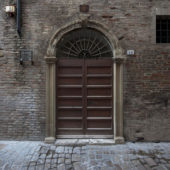An outstanding example of Baroque design with a most unusual bi-polar layout and raised Tivah reached by double staircases of 15 steps.
An ancient rabbinical reference attests to the existence of a Jewish community in Pesaro since 1214. It is reasonable to infer that Jews settled in the city even earlier, attracted to the area by its commercial importance. Pesaro’s Jewish community was engaged in crafts, money lending, and local and regional trade. Jews provided money lending to the poor, and supplied floating capital to local artisans and merchants. They also provided financial support to farmers in anticipation of the crops and lent large amounts of money at low interest rates to local municipalities, eminent personalities and noblemen. These loans were generally granted on the basis of written receipts without a guarantee.
In 1548, Manoel Lopes Bichacho, formerly a leader of the Portuguese Nation in Antwerp, settled in Pesaro and obtained a banking license. According to Samuel Usque, in 1549, when the duke of Ferrara expelled all the recent arrivals from his city, Manoel Bichacho persuaded Duke Guidobaldo to allow some of them to settle on his lands. In 1550, he was granted up to 35 merchants living on his land – this was the unusual beginning of the Portuguese Nation in Pesaro. In 1556, in the wake of the persecutions against the former Marranos of Ancona, several of them fled to Pesaro. After the expulsion of the Jews from the Papal States in 1569, several refugees found shelter in Pesaro.
In 1631 when the Duchy of Urbino fell under papal rule, the oppressive legislation extended to Pesaro. By 1634 the Jews were forced to live in a ghetto and to wear identifying yellow arm badges. They were forbidden to own real estate and their commercial activities were drastically curtailed. Jewish physicians were no longer allowed to practice medicine amongst Christians, nor were Jews allowed to employ Christians. As a result, many Jews left Pesaro, with numbers dwindling from 630 in 1628 to barely 500 in 1656. Numbers continued to decrease in the following century and by 1747 there were only 407 Jews in the community. However, in the 18th century, enforcement of the oppressive legislation relaxed. In 1797, when French forces occupied the city, the gates of the ghetto were thrown open and the Jews were declared full citizens. However, their freedom did not last for long and the Jews were again oppressed. In 1860 Pesaro was annexed to the Kingdom of Italy and the Jews were emancipated. As a result many families moved out of the ghetto to the center of town. By 1869 only 160 Jews still lived in the area of the former ghetto. At the beginning of the 20th century only 60 Jews lived in Pesaro. By 1940, the number of Jews had shrunk to only a few individuals.
Until 1633, the year the ghetto was established, the city of Pesaro had three synagogues and numerous prayer rooms. One synagogue was for the Hispano-Levantine rite, and the other two followed the native Italian rite. The Synagogue of Pesaro was commissioned and financed by Mordekhaj Volterra, a wealthy Portuguese banker, prior to leaving for Florence where he became the financial and political adviser to Francesco de Medici. The synagogue dates back to 1642 and was a complex comprising not only the synagogue, but also community offices, a day school, music school and a center for Kabbalah studies.
The Italian rite synagogue fell outside the newly established ghetto and was therefore closed. Thereafter only the Pesaro Synagogue was used. The boarded-up Italian synagogue was badly damaged in the 1930 earthquake and subsequently demolished in 1940. During the Nazi occupation the Pesaro Synagogue was closed. In 1944 the Palestinian Brigade of the British Army reopened the Pesaro Synagogue and services were held there for the last time, with almost no Jewish population left. It was then left abandoned and deteriorated rapidly. With the agreement of the Jewish Community in Ancona, which owned the building, the City of Pesaro began to restore the synagogue in 1990. Restoration was completed in 2004 and the building opened as an historical site.
The exterior is nondescript, with no identifying signs or plaques revealing that the building is a synagogue. Surrounding the main entrance double-leafed door is a 19th century copy of the original stone portal. Each leaf boasts six panels. There were originally five: for the five fingers of each hand, symbolizing giving and not taking, generosity and spirituality. The ground floor houses an exhibition featuring the life of Pesaro’s community, displaying various artifacts and ritual objects, as well as an oven and a bath for the purification of the worshippers and a well. The prayer room, once known as the “treasure of Pesaro,” retains its original splendor. The large rectangular room, decorated in splendid baroque style, is sunlit from generous windows. The ceiling is magnificent with intricate, hand-painted moldings. The fourth wall encloses the women’s galleries, upstairs. The prayer room is decorated in subdued colors: whites, grays, blues and soft browns. Benches line the walls, contrasting natural wood with panels of deep green.
At the eastern end of the prayer room, facing Jerusalem, is a large niche reserved for the Aron Kodesh, created in 1708 by Angelo Scoccianti, a cabinet maker from Cupramontana. It was sculpted of wood, flanked by columns and gilded, and is now in the synagogue of Livorno, Italy. (It may be seen on this website.) At the western end of the room, in typical Sephardic rite, was the elaborately carved and gilded tivah (reader’s desk). The tivah was given to the Levantine synagogue in Ancona. (The tivah may also be seen on this website.) The remains of the prayer hall are considered to be a national monument. On the west side of the room, a balcony is accessed on either side by marble staircase of fifteen stairs. These are joined by an elegant landing flanked by red marble columns supporting elegant archways under the ornate ceiling. Behind the landing, what were once badly damaged 19th century temperas have been restored to wall paintings depicting the city of Jerusalem and the encampment of the Jews at the foot of Mount Sinai. The balcony was probably used for a cantor or choir, as music was of utmost importance in the Sephardic rite. Terracotta and ivory diamond-shaped tiles line the floor. The abandoned cemetery nearby was cleared of its rampant vegetation, its terraces rebuilt and reinforced and the sepulchral stones dug up.

